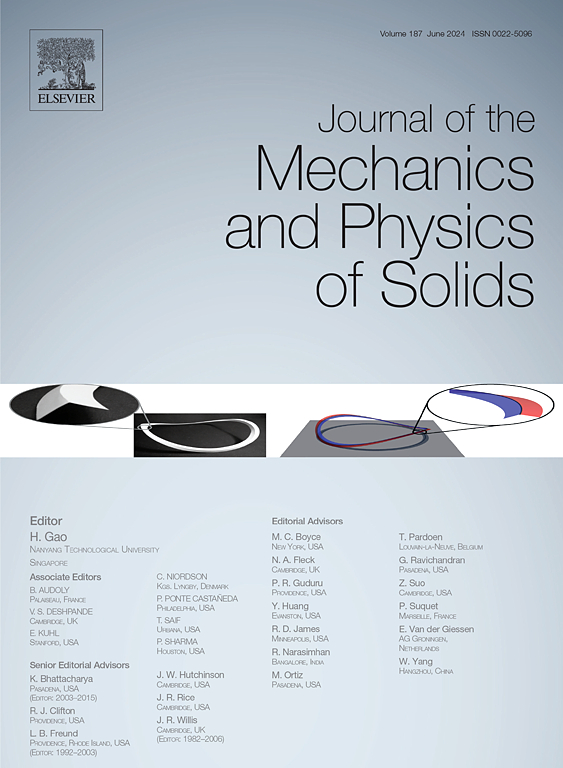A steady-state frictional crack in a strip
IF 5
2区 工程技术
Q2 MATERIALS SCIENCE, MULTIDISCIPLINARY
引用次数: 0
Abstract
The analogy between frictional cracks, propagating along interfaces in frictional contact, and ordinary cracks in bulk materials is important in various fields. We consider a stress-controlled frictional crack propagating at a velocity along an interface separating two strips, each of height , the frictional counterpart of the classical problem of a displacement-controlled crack in a strip, which played central roles in understanding material failure. We show that steady-state frictional cracks in a strip geometry require a nonmonotonic dependence of the frictional strength on the slip velocity and, in sharp contrast to their classical counterparts, feature a vanishing stress drop. Here, rupture is driven by energy flowing to its edge from behind, generated by an excess power of the external stress, and to be accompanied by an increase in the stored elastic energy, in qualitative contrast to the classical counterpart that is driven by the release of elastic energy stored ahead of the propagating edge. Finally, we derive a complete set of mesoscopic and macroscopic scaling relations for frictional cracks in a strip geometry and demonstrate that the stress singularity near their edges is proportional to , where is the slip velocity rise accompanying their propagation. The relevance of our findings for various phenomena, including slow rupture/earthquakes, is briefly discussed.
带材上的稳态摩擦裂纹
将沿摩擦接触界面传播的摩擦裂纹与块状材料中的普通裂纹进行类比,在各个领域都具有重要意义。我们考虑一个应力控制的摩擦裂纹沿分离两条高度为H的条带的界面以速度cr传播,这是条带中位移控制裂纹的经典问题的摩擦对应,在理解材料破坏方面发挥了核心作用。我们表明,条形几何中的稳态摩擦裂纹需要摩擦强度与滑移速度的非单调依赖,并且与经典对应的摩擦裂纹形成鲜明对比,其特征是应力降消失。在这里,破裂是由从后面流向其边缘的能量驱动的,这是由外部应力的过剩功率产生的,并伴随着存储的弹性能量的增加,这与经典对应的是由在传播边缘之前存储的弹性能量的释放驱动的定性对比。最后,我们推导出了一套完整的条形摩擦裂纹的细观和宏观尺度关系,并证明了摩擦裂纹边缘附近的应力奇点与(Δv/cr)H成正比,其中Δv为摩擦裂纹扩展时的滑移速度上升。我们的发现与各种现象的相关性,包括缓慢破裂/地震,简要讨论。
本文章由计算机程序翻译,如有差异,请以英文原文为准。
求助全文
约1分钟内获得全文
求助全文
来源期刊
CiteScore
9.80
自引率
9.40%
发文量
276
审稿时长
52 days
期刊介绍:
The aim of Journal of The Mechanics and Physics of Solids is to publish research of the highest quality and of lasting significance on the mechanics of solids. The scope is broad, from fundamental concepts in mechanics to the analysis of novel phenomena and applications. Solids are interpreted broadly to include both hard and soft materials as well as natural and synthetic structures. The approach can be theoretical, experimental or computational.This research activity sits within engineering science and the allied areas of applied mathematics, materials science, bio-mechanics, applied physics, and geophysics.
The Journal was founded in 1952 by Rodney Hill, who was its Editor-in-Chief until 1968. The topics of interest to the Journal evolve with developments in the subject but its basic ethos remains the same: to publish research of the highest quality relating to the mechanics of solids. Thus, emphasis is placed on the development of fundamental concepts of mechanics and novel applications of these concepts based on theoretical, experimental or computational approaches, drawing upon the various branches of engineering science and the allied areas within applied mathematics, materials science, structural engineering, applied physics, and geophysics.
The main purpose of the Journal is to foster scientific understanding of the processes of deformation and mechanical failure of all solid materials, both technological and natural, and the connections between these processes and their underlying physical mechanisms. In this sense, the content of the Journal should reflect the current state of the discipline in analysis, experimental observation, and numerical simulation. In the interest of achieving this goal, authors are encouraged to consider the significance of their contributions for the field of mechanics and the implications of their results, in addition to describing the details of their work.

 求助内容:
求助内容: 应助结果提醒方式:
应助结果提醒方式:


